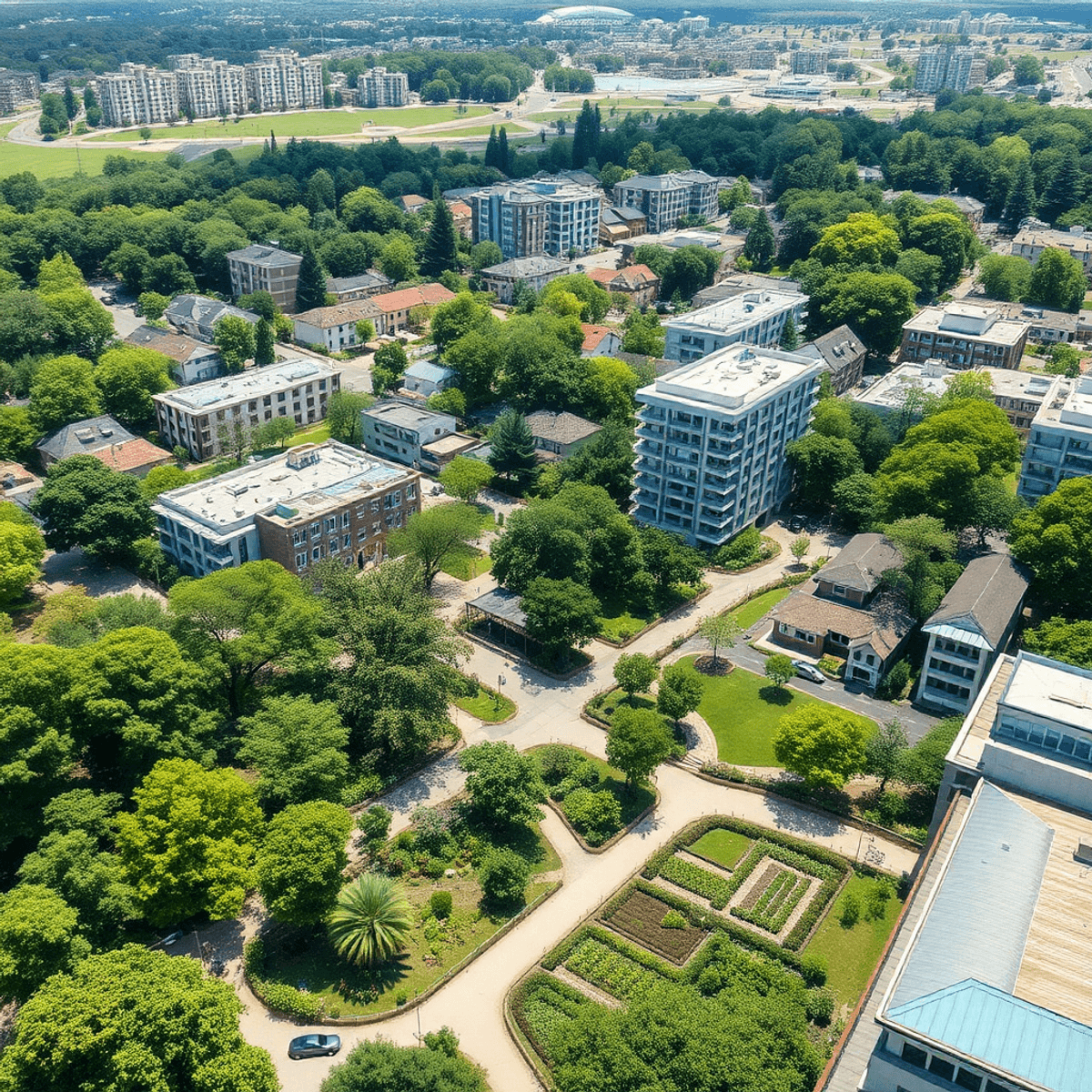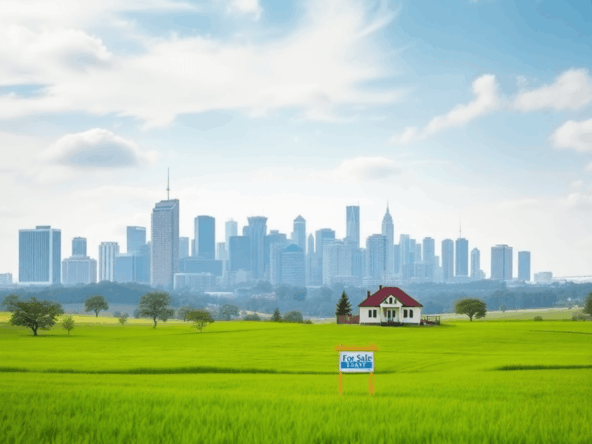Introduction
Land stewardship refers to the responsible management of land resources, emphasizing sustainability and environmental care. As urbanization accelerates, balancing development with environmental preservation becomes crucial. This balance is not merely a choice but a necessity for ensuring a healthy planet for future generations.
Importance of Balancing Development with Environmental Care
- Sustainable Growth: Aligning community needs with ecological integrity fosters long-term benefits.
- Legacy Building: Land is more than a commodity; it transforms lives and shapes futures.
- Social Responsibility: A commitment to environmental stewardship reflects an obligation to give back to local communities.
What You Will Learn
This article will provide insights into:
- The principles guiding effective land stewardship.
- Successful examples of urban planning initiatives that harmonize development and environmental needs.
- Strategies for community engagement in fostering sustainable practices.
Understanding these elements is essential for anyone interested in making informed decisions about land use and promoting a sustainable legacy.
Understanding Land Stewardship
Land stewardship is all about taking care of the land responsibly, using sustainable methods that honor ecosystems. This idea has a long history in America, growing from indigenous practices and early settlers’ interactions with the land to modern approaches that prioritize both environmental health and development.
Historical Context
1. Indigenous Practices
Native Americans practiced land stewardship for centuries, understanding the interconnectedness of nature. They utilized sustainable methods that nurtured the environment while meeting their needs.
2. Colonial Era
Early American settlers often viewed land as a resource to exploit. Over time, awareness grew regarding the negative impacts of unchecked development, leading to a shift in perspective.
Modern Perspectives
Today, land stewardship emphasizes the importance of balancing human activity with ecological preservation. This approach recognizes:
- Ecosystem Health: Healthy ecosystems support biodiversity, clean water, and air quality. Protecting these natural systems is vital for future generations.
- Sustainable Development: Integrating land management practices that focus on renewable resources fosters economic growth without compromising environmental integrity.
Fostering a Sustainable Future
Land stewardship plays a critical role in shaping a sustainable future by promoting:
- Conservation Efforts: Preserving wildlife habitats and natural landscapes ensures ecosystems remain intact. This can involve responsible land-use planning and rehabilitation of degraded areas.
- Community Engagement: Encouraging local communities to participate in stewardship initiatives enhances awareness and responsibility toward natural resources. Education about sustainable practices fosters a culture of care.
In essence, effective land stewardship nurtures the relationship between people and the environment. It transforms how we perceive land—from merely a commodity to a shared legacy deserving thoughtful stewardship.
Key Principles Guiding Effective Land Stewardship
1. Sustainable Growth in Land Use Policies
Sustainable growth in land use policies refers to the practice of developing land in a manner that meets present needs without compromising the ability of future generations to meet their own. This concept is pivotal in balancing development with environmental care, ensuring that urban planning initiatives foster vibrant neighborhoods while preserving natural resources.
Definition and Significance of Sustainable Growth
Sustainable growth emphasizes several core principles:
- Resource Efficiency: Utilizing land and resources in a way that minimizes waste and maximizes benefits.
- Environmental Protection: Incorporating strategies to mitigate negative impacts on ecosystems, such as air and water quality.
- Social Equity: Ensuring all community members have access to essential services, green spaces, and recreational areas.
The significance of sustainable growth cannot be overstated. It addresses the challenges posed by rapid urbanization, population growth, and climate change. By adopting sustainable practices, communities can create environments that promote health, well-being, and economic opportunity.
Successful Urban Planning Initiatives
Several urban planning initiatives exemplify the successful integration of sustainable growth principles into effective land use policies:
- Portland, Oregon: Known for its innovative urban growth boundary (UGB), Portland has effectively controlled urban sprawl. The UGB limits the expansion of city boundaries while promoting higher density within existing areas. This approach has led to increased public transportation usage and reduced reliance on cars, contributing to lower greenhouse gas emissions.
- Vauban District in Freiburg, Germany: This eco-neighborhood prioritizes sustainability through green building practices, car-free streets, and communal green spaces. Residents engage with local resources while enjoying easy access to parks and public transport. The Vauban model demonstrates how thoughtful urban design fosters community engagement alongside environmental stewardship.
- Toronto’s Green Standard: A set of guidelines designed to enhance sustainability in new developments, Toronto’s Green Standard encourages developers to integrate features such as green roofs, stormwater management systems, and energy-efficient building designs. This initiative promotes a healthy environment while enhancing the livability of neighborhoods.
- Melbourne’s Urban Forest Strategy: Recognizing the importance of trees for climate adaptation and community well-being, Melbourne has implemented policies aimed at increasing canopy cover across the city. Initiatives include planting more trees in public spaces and encouraging private landowners to do the same. These efforts contribute to improved air quality and provide cooling effects during heat waves.
- Singapore’s Garden City Vision: Singapore integrates nature into its urban landscape through extensive parks and greenery within residential areas. The city-state promotes biodiversity while creating attractive living environments that enhance residents’ quality of life.
Challenges and Considerations
Despite these successes, implementing sustainable growth policies comes with challenges:
- Community Resistance: Sometimes local communities may resist changes due to concerns over property values or changes in neighborhood character.
- Economic Pressures: Developers might prioritize short-term profits over long-term sustainability goals.
- Policy Coordination: Effective land use often requires collaboration among various stakeholders including government agencies, private developers, and community organizations.
Addressing these challenges involves fostering dialogue among stakeholders to ensure all perspectives are considered:
- Engaging communities early in the planning process can mitigate resistance by allowing residents to voice their concerns.
- Developing incentives for environmentally-friendly construction can encourage developers to embrace sustainable practices.
- Coordinated policy frameworks can streamline efforts across departments ensuring cohesive strategies are employed.
By understanding the importance of sustainable growth in land use policies and examining successful examples from around the globe, communities can better navigate the complexities associated with balancing development with environmental care.
2. Environmental Stewardship Policies for a Greener Future
Environmental stewardship policies are essential for promoting sustainable growth in urban areas. Organizations like the Port of Seattle serve as excellent examples of effective environmental stewardship principles. They demonstrate their commitment to sustainability through various initiatives that aim to involve the community, create vibrant neighborhoods, and tackle ecological issues.
Key elements include:
- Habitat Management: Comprehensive habitat management strategies focus on preserving natural ecosystems and biodiversity. These policies ensure that development projects incorporate green spaces, wetlands, and wildlife corridors, allowing for the coexistence of urban life and nature.
- Tree Replacement Programs: Such programs are vital in mitigating the effects of urbanization on local ecosystems. For every tree removed during construction, organizations often commit to planting several new ones, contributing to a healthier urban canopy and improved air quality.
Integrating these principles into urban planning leads to long-term success by creating spaces that are not only functional but also environmentally responsible. The emphasis on community involvement ensures that residents have a voice in decision-making processes, allowing them to advocate for sustainable practices that benefit their neighborhoods.
The Port of Seattle’s approach illustrates how effective land use policies can align with community values and ecological needs. Their environmental stewardship framework serves as a model for other municipalities aiming to strike a balance between development and environmental care.
Incorporating these strategies fosters a culture of responsibility towards the land, encouraging individuals and organizations alike to prioritize sustainability in their daily practices. This commitment ultimately contributes to the overarching goal of responsible land stewardship, creating a legacy of care for future generations.
Global Challenges and Policy Recommendations for Effective Land Stewardship
The United Arab Emirates (UAE) presents a compelling case study on the balance between rapid economic development and environmental preservation. As one of the fastest-growing economies in the world, the UAE faces unique challenges due to its urbanization and climate change impacts. The rapid expansion of cities like Dubai and Abu Dhabi has led to significant environmental pressures, including habitat loss, increased carbon emissions, and water scarcity.
Key Challenges
- Urbanization: The swift construction of infrastructure often overlooks natural ecosystems.
- Climate Change: Rising temperatures and sea levels threaten coastal developments and biodiversity.
- Resource Depletion: Over-extraction of water resources strains local ecosystems.
Proposed Strategies for Sustainable Urban Planning
-
Integrated Urban Development Plans
- Encourage collaboration among government entities, private sectors, and communities to create comprehensive urban planning strategies.
- Prioritize green spaces and natural habitats within urban environments.
- Implement effective land stewardship practices to maintain ecological balance.
-
Sustainable Building Practices
- Promote eco-friendly construction materials and energy-efficient designs.
- Implement regulations that mandate sustainable practices in new developments.
-
Public Awareness Campaigns
- Educate citizens about the importance of environmental stewardship.
- Foster community involvement in local sustainability initiatives.
-
Incentives for Green Technologies
- Provide financial incentives for businesses adopting environmentally friendly technologies.
- Encourage investments in renewable energy solutions to reduce reliance on fossil fuels.
-
Strengthening Environmental Policies
- Establish stricter regulations regarding land use and natural resource management.
- Create effective monitoring systems to ensure compliance with environmental standards.
Through these strategies, the UAE can navigate the complexities of its rapid development while safeguarding its environment. Balancing growth with ecological integrity is essential for sustainable progress, ensuring that future generations inherit a thriving planet.
Community Engagement: The Key to Successful Land Stewardship Initiatives
Active participation from local communities is essential in aligning development with environmental goals. Engaging residents creates a sense of ownership and responsibility, fostering sustainable practices that benefit both the community and the environment.
Importance of Community Involvement
- Enhances Decision-Making: Local insights help shape policies that reflect community needs and environmental considerations.
- Builds Trust: Collaboration between stakeholders encourages transparency and mutual respect, vital for effective land stewardship.
Examples of Educational Initiatives
- Sustainability Workshops: Community-driven workshops focused on topics like conservation techniques and sustainable agriculture practices empower individuals with knowledge.
- School Programs: Integrating environmental education into school curricula raises awareness among younger generations, instilling values of sustainability early on.
- Local Clean-Up Events: Organizing clean-up days fosters teamwork while directly benefiting natural spaces, reinforcing the community’s role in stewardship.
These initiatives not only educate but also inspire collective action towards a greener future. Encouraging active participation helps communities navigate the complexities of balancing development with environmental care, making it an integral part of land stewardship efforts. Furthermore, community involvement in environmental protection is crucial for the success of these initiatives.
Conclusion: Building a Sustainable Legacy Through Responsible Land Management Practices
Balancing human activity with environmental care is essential for the well-being of future generations. Responsible land stewardship practices provide a framework for achieving this harmonious balance. Effective stewardship fosters sustainable development while ensuring that natural resources are preserved for years to come.
Engaging with your community can amplify the impact of these practices. Consider these actions:
- Participate in local conservation efforts
- Support educational programs on sustainability
- Advocate for policies that prioritize environmental stewardship
Each small effort contributes to a larger movement towards sustainability.
Legacy Country exemplifies this commitment by embodying values of social responsibility and long-term success. Their approach to land management not only addresses current needs but also secures a promising future for the land and its inhabitants.
If you’re interested in learning more about effective land stewardship, reach out to us. Together, we can build a legacy rooted in care and responsibility, ensuring that our environment thrives alongside development.




